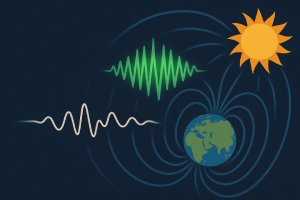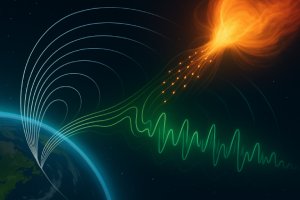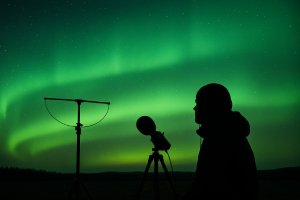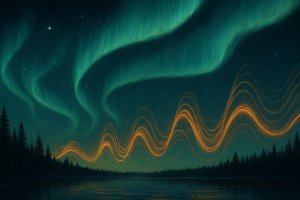What Is an Auroral Chorus?

Auroral choruses are naturally occurring electromagnetic waves in the ELF-VLF spectrum generally in the frequency range of 0.3-30 kHz. When converted to sound waves perceivable by human ears, these sounds would almost qualify as music-the chirps, whistles, and rising tones seem to dance in harmony. Scientists call them quasi-musical since their sounds contain harmonic structures and repeating patterns, but they do not arrange into music per se.
These VLF waves are usually observed during geomagnetic storms, which are generated when the solar wind- a stream of charged particles emitted by the Sun- interacts with the Earth's magnetosphere. As charged particles funnel along magnetic field lines toward the poles, they may incite plasma oscillations that travel down as VLF waves. The auroral chorus is basically an audio representation of this plasma action, recording the dynamic energy of a moving magnetosphere.
How Auroral Chorus Is Formed

The first part of auroral chorus formation starts in the magnetosphere, a space protected by the Earth's magnetic field. During high solar activity, caused by solar flares or coronal mass ejections, the magnetosphere becomes energized, and electrons are sped up along magnetic field lines toward the polar regions.
The high-energy electrons really create a great show for the plasma in the magnetosphere by the electromagnetic waves. Electromagnetic waves are thus amplified through wave-particle interactions: the movement of charged particles actually induces oscillations in the electromagnetic field while they get reinforced. When VLF waves get into the ionosphere and are converted into pressure waves in the atmosphere, the audible signals become chirps and whistles.
Another interesting note is that the auroral orchestra very often exhibits rising tones; hence, the increase in frequency over time produces that characteristic 'chirping' sound. Scientists are yet to learn that electron populations drift and interact along magnetic field lines, to produce systematic variations in the wave frequency.
Observation of Auroral Chorus

Unlike visual auroras that can be seen, auroral chorus cannot normally be heard without the aid of any special instrument. By means of sensitive instruments, VLF receivers is a prime example of such an instrument, a person can detect the electromagnetic signals of such an event and record them. Subsequently, these recordings can be converted into sounds, and the strange and fascinating audio terrain of the magnetosphere can be explored.
These choruses are frequently heard throughout strong geomagnetic storms, which have a greater chance of occurring near the poles. Occasionally, under intense solar activity, they can be detected even at mid-latitudes. These VLF signals are what amateurs for radio and some atmospheric researchers try to catch. In such a way, they hear the chorus being formed by the call of the sky; it remains surreal to think that the magnetic ambience of the Earth is dramatized with invisible activities.
The Science Behind the Sounds
Post-1950s, with the discovery of the phenomenon, much scientific investigation has taken place concerning auroral chorus. It has been established that chorus patterns depend on the density and energy of the electrons present in the magnetosphere, as well as the direction of orienting and the magnitude of Earth's magnetic field.
Auroral chorus waves are considered crucial in the space weather dynamics. The waves scatter the energetic electrons, and this either modifies the radiation belts about Earth or sometimes affects satellite operations. Thus, in this regard, auroral chorus has ceased being an auditory curiosity and has become an essential part of the system that protects the Earth from harmful solar radiation. Through their study of these waves, scientists understand how Sun's energy is passed around the magnetosphere and how geomagnetic storms develop with time.
Cultural and Scientific Significance

The auroral chorus had drawn the interest of artists and musicians. The ethereal voices are sampled in experimental music and sound art to create a sensation out of cosmic physics. Beyond its artistic appeal, the auroral chorus ought to be studied for understanding space weather, which can affect satellite communications, GPS systems, and power grids on Earth.
Translating the waves into sound allows researchers to gain more intuition regarding magnetospheric dynamics. The auroral chorus provides a bridge between invisible physical processes and human perception, in other words, an opportunity for us to listen to the Sun's energy being converted as interaction with Earth.
When the Sky Sings
The auroral chorus represents a beautiful example of a phenomenon that can create light and sound on Earth. These electromagnetic waves are produced by energetic electrons during geomagnetic storms, producing chirps, whistles, and quasi-musical tones when transduced into sound. For the magnificent appeal of these auroral waves, the scientists also glean crucial information about magnetospheric physics and space weather. For some, whether through the uses of scientific equipment or through artistic reinterpretations, give that rare connection of the auroral chorus with the ever-evolving forces behind the making of this earth.
Contributors
